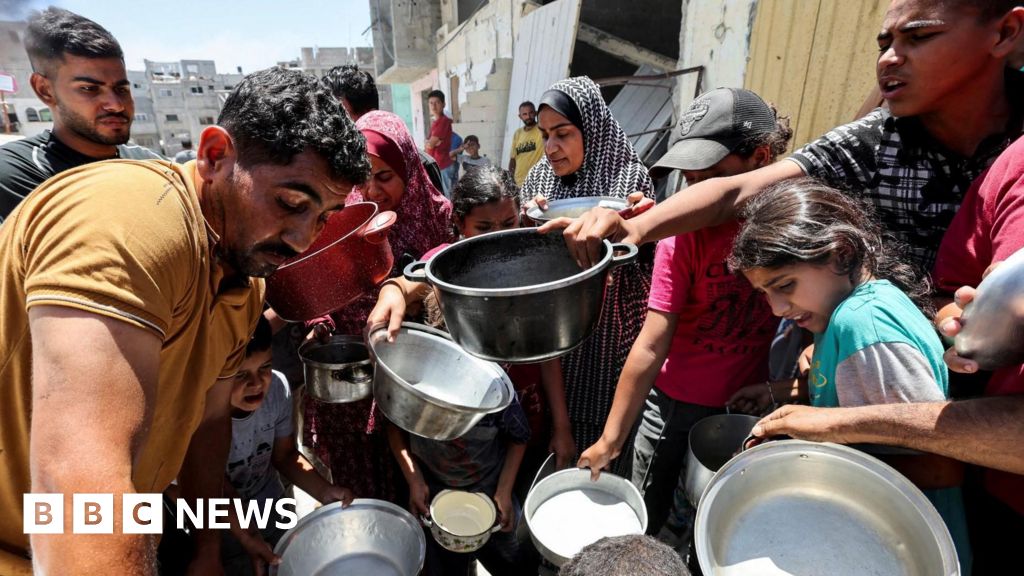War between Israel and Gaza: UN-backed assessment: “High risk” of famine still exists

- Author, David Gritten
- Role, BBC News
According to a UN-backed assessment, nearly half a million Palestinians across the Gaza Strip still suffer from “catastrophic” hunger, and as long as the war between Israel and Hamas continues and humanitarian access is restricted, there remains a “high risk” of famine.
However, the Integrated Food Security Phase Classification (IPC) report states that the available evidence does not suggest that famine is currently occurring in the north of the Palestinian territory.
The previous assessment in March had indicated that such a rush was imminent in the area.
Since then, the amount of food and other aid allowed into the north has increased, and supplies of food, water, sanitation and health services have also been strengthened, the report said.
However, it also warns that the availability of food in the south and central Gaza Strip has been severely limited due to the closure of the Rafah crossing and the displacement of over a million people from the city of Rafah since early May, when Israel launched a ground operation there.
The United Nations World Food Programme (WFP) said the report “paints a grim picture of persistent hunger” and shows how crucial sustained humanitarian access is.
UN officials have blamed the situation on Israeli military restrictions on aid deliveries, ongoing hostilities and the breakdown of law and order.
Israel insists there are no limits on the amount of aid that can be delivered to and through Gaza, and blames UN agencies for the lack of aid distribution. Israel also accuses Hamas of stealing aid, which the organization denies.
In response to an unprecedented attack on southern Israel on October 7, the Israeli military launched a campaign to annihilate Hamas. The attack killed around 1,200 people and took 251 others hostage.
According to the Hamas-run Health Ministry, more than 37,650 people have been killed in the Gaza Strip since then.
The IPC – a global initiative of UN agencies, aid organizations and governments – is the primary mechanism the international community uses to determine whether a famine exists.
Households are classified into IPC Phase 5 (catastrophe) when they suffer from extreme food shortages, hunger, and exhaustion of their coping strategies.
For a famine to be officially declared in a particular area, there must be evidence that at least 20 percent of households are in Stage 5, 30 percent of children are suffering from acute malnutrition, and there are two deaths per 10,000 population, or four deaths per 10,000 children per day, “due to total starvation or the combination of malnutrition and disease.”
“Contrary to the assumptions for the forecast period (March – July 2024), the amount of food and non-food items allowed to be imported into the northern governorates has increased,” it says.
“In addition, measures in the areas of nutrition, water, sanitation (WASH) and health have been strengthened. In this context, the available evidence does not indicate that a famine currently exists.”
Although an estimated 20 percent of households in the north are in Phase 5, the thresholds for acute malnutrition and mortality have not yet been exceeded, the statement said.
The World Health Organization said earlier this month that local health authorities had reported 32 deaths from malnutrition, including 28 among children under five.
The IPC report warns that there remains “a high and ongoing risk of famine throughout the Gaza Strip” and that improvements in April and May “should not give rise to complacency.”
The WFP said the “slight improvement” noted in the IPC report showed the difference improved access could make, but stressed the situation was “still hopeless”.
“To truly overcome the crisis and prevent famine, sufficient and sustained humanitarian assistance must be provided,” it continues.
Meanwhile, the head of the UN Relief and Works Agency for Palestine Refugees (UNRWA) told reporters in Geneva that on average at least ten children a day were losing one or both legs as a result of the war.
Philippe Lazzarini said this figure did not include children who had lost hands or arms. The amputations were usually carried out in “pretty terrible conditions” and sometimes without anesthesia, he described.
In Gaza, at least 24 people were reportedly killed in three Israeli air strikes in the northern Gaza Strip early Tuesday, including the sister of Qatar-based Hamas political leader Ismail Haniyeh.
Health officials told Reuters that 14 people were killed in attacks on two schools used as shelters by displaced people in Gaza City’s central Daraj district and the Shati urban refugee camp to the north.
The Israeli military said in a statement that planes had hit “two buildings in Shati and Daraj used by Hamas terrorists.”
“The terrorists operated on school premises that served as a shield for Hamas’ terrorist activities,” it said. Some of them were accused of involvement in the October 7 hostage-taking and attack.
Hamas had previously denied using schools for military purposes.
The other ten people were reportedly killed in an attack on a house in Shati at dawn. A neighbor and Palestinian media identified the dead as Ismail Haniyeh’s sister Zahr and nine members of her family.
Mr Haniyeh – who also lost three of his sons and several grandchildren in an attack in April – said the killing of his relatives would not persuade Hamas to change its stance and reiterated the group’s calls for a ceasefire and the release of the hostages.
The Israeli military has not yet commented on the reports.
Physiotherapist Fadi al-Wadiya was killed along with five other people, including three children, as he cycled to the Doctors Without Borders clinic where he worked, the aid organization said, but did not blame anyone.
The Israeli military later announced that it had killed Fadi al-Wadiya in an airstrike, accusing him of being a “major (Palestinian) Islamic Jihad terrorist” who developed the group’s missile arsenal.



